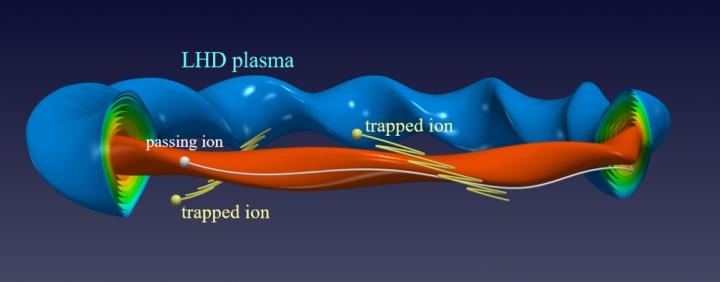Jun 30 2020
Researchers led by Assistant Professor Masahiko Sato and Professor Yasushi Todo from the National Institutes of Natural Sciences (NINS) National Institute for Fusion Science (NIFS) have successfully reproduced the high-pressure plasma confinement observed in the Large Helical Device (LHD) with the help of computer simulation.
 The passing ion (white sphere) moves in one direction. On the other hand, the trapped ion (yellow sphere) moves back-and-forth and the center of the back-and-forth motion also moves simultaneously in helical direction, which is a characteristic of the LHD. The plasma pressure is constant in each colored surface, and the plasma pressure is high in the central region. Image Credit: National Institute for Fusion Science.
The passing ion (white sphere) moves in one direction. On the other hand, the trapped ion (yellow sphere) moves back-and-forth and the center of the back-and-forth motion also moves simultaneously in helical direction, which is a characteristic of the LHD. The plasma pressure is constant in each colored surface, and the plasma pressure is high in the central region. Image Credit: National Institute for Fusion Science.
The study outcomes have facilitated highly precise estimations of plasma behavior with the goal of achieving an economical helical fusion reactor.
For fusion energy to be realized, high-pressure plasma must be confined for a long duration using the magnetic field. It is feasible to confine plasma at higher pressure by using a stronger magnetic field, but it incurs more cost to produce a stronger magnetic field using electromagnetic coils.
Therefore, if the magnetic field strength is the same, a device with the ability to confine higher pressure plasma is economically preferable. Since the LHD has successfully maintained high-pressure plasma, there is a higher expectation in achieving a helical fusion reactor.
For a future fusion reactor, design research is carried out based on computer simulations that predict the behavior of magnetically confined plasma. For this, highly accurate simulations are required. Accuracy can only be confirmed by performing simulations to reproduce the experimental results achieved by the existing devices.
But the simulations had not replicated the experimental results achieved by the LHD indicating the maintenance of high-pressure plasma. This has been a major obstacle in the design research for a less expensive helical fusion reactor.
High-pressure plasma in the LHD was previously simulated using a model where the plasma is regarded as a fluid. In such a fluid model, the motion is averaged over several ions contained in the plasma, and the difference among the ions with different velocities is neglected.
At NIFS, researchers developed a program that calculates individual motions of several ions to enhance the simulation accuracy. Dubbed “the hybrid simulation program,” this program has been employed to analyze energetic ions that play a crucial role in sustaining high-temperature plasma within a future fusion reactor.
Both Masahiko Sato and Yasushi Todo made efforts to simulate high-pressure plasma confinement in the LHD with the help of the hybrid simulation program. Their focus was on the ions that move back-and-forth, also called “trapped ions,” and whose motion is characteristic to the LHD.
The researchers tested the effect of the trapped ions by analyzing the long-time evolution of plasma pressure and tens of millions of ions, which included millions of trapped ions.
A simulation such as that needs huge amounts of calculations, the researchers made complete use of the “Plasma Simulator” (NIFS’ supercomputer) and have reproduced the LHD experimental result indicating that high-pressure plasma is sustained.
A detailed analysis of the simulation data showed that the trapped ions contribute considerably to the stable confinement of high-pressure plasma by inhibiting the fluctuations that can lead to the reduction of plasma pressure.
In this way, the researchers have considerably enhanced the prediction accuracy of high-pressure plasma in a future helical fusion reactor. They expect this study will help accelerate the design research focused on an economical helical reactor.
Journal Reference:
Sato, M & Todo, Y (2020) Ion kinetic effects on linear pressure driven magnetohydrodynamic instabilities in helical plasmas. Journal of Plasma Physics. doi.org/10.1017/S0022377820000501.